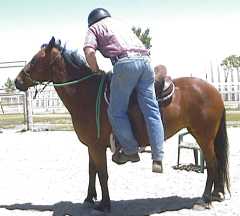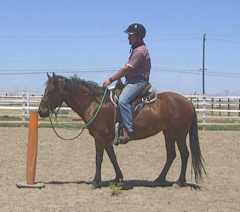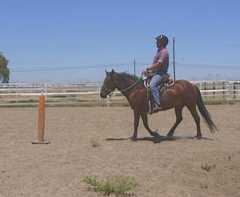KBR Training Information Sheet:Moving "Stuck" HorsesOnce in a while we'll come across a horse who is content just to stand still when mounted. With some you can work on teaching them to move from pressure on the ground and they will carry that idea over when under saddle. With a few you can have someone lead them off while you apply leg aids and they'll get the idea. Still others can be longed while being ridden and will learn to associate the leg aids with movement when assisted by the ground person. But once in a while we'll run across a horse who will simply stop moving when all the "artificial stimulations" cease. | ||
|
The horse in this instance is our former little "untouchable" case study. She knew how to target from clicker training so Sharon suggested we take her out to the riding arena, scatter some targets about, and move her from one target to the next. For those of you unfamiliar with Patience, we had sat on her a couple of times and did some walking (under protest) in the round corral, and even tried an awkward episode of leading her in the large arena while under saddle. Basically this horse has had no real saddle time and here we took her out into a 100 x 160 ft. arena in which we scattered chairs, a bucket and a traffic pylon. To start out, Sharon held a target. I mounted up and Sharon verbally cued Patience to touch the target which the horse did. Then Sharon clicked and Patience got her treat. Patience was now into the game. Next Sharon stepped away a few steps, cued Patience to touch the target and I'd give her a little squeeze with my legs. Patience would walk to her and touch the target. Next we progressed to the traffic pylon. Sharon asked Patience to touch it, I gave her a squeeze and she walked to the pylon. Sharon moved the pylon a couple of times until Patience was really solid at this. Then we tried a bucket and a chair. OK, so we got the horse to walk to a target. How does this help us train her under saddle? At this point there were targets scattered about the arena. Patience had associated moving forward with doing something right. Now I would ask her to move forward with my legs and guide her to whichever target I wished her to approach by applying light rein and leg aids. When she touched the correct target, she got a click and a reward. Pretty soon we were passing up closer targets to reach more distant ones and we did this for about an hour without the horse losing interest. Eventually we ended the game because this horse was not used to being under saddle and we didn't want her to get sore as a result of the work. But by the end of the drill, she would stand quietly until asked to move, she would move off leg pressure and she could be guided virtually anywhere in the arena. Now as a practical matter Cindy can't send out a pickup truck ahead of her to leave chairs and pylons all over the trail as targets when she wants to go riding, so we will reduce our dependency on the targets as we continue the lessons, using them only as necessary if Patience gets "stuck."
|
Mounting up
| |
Press "Back" to return to the page that brought you hereReturn to Case Study SectionReturn to Training SectionReturn to Wild Horse MentorsReturn to KBR World of Wild Horses and BurrosGo To
| ||



